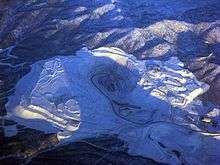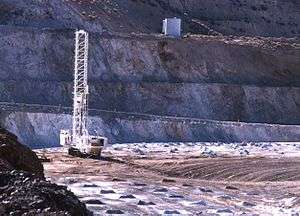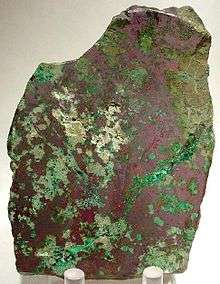Robinson Mine
| Location | |
|---|---|
 Robinson Mine Location in Nevada | |
| Location | White Pine County |
| State | Nevada |
| Country | United States |
| Coordinates | 39°15′35″N 114°58′36″W / 39.25982°N 114.97676°WCoordinates: 39°15′35″N 114°58′36″W / 39.25982°N 114.97676°W |
| Production | |
| Products | Copper, Gold, Molybdenum |
| History | |
| Opened | 1904 |
| Owner | |
| Company | KGHM Polska Miedź |
| Website | Robinson Mine webpage |
| Year of acquisition | 2004 |
The Robinson Mine is a porphyry copper deposit located in the Robinson Mining District, adjacent to Ruth in White Pine County, Nevada. In early 2012 the mine was acquired by Polish KGHM Polska Miedz.
Large-scale copper mining began in the district in 1907 and, with some hiatuses and several changes of ownership, continues in 2015. Production from 1908 to 1978 was more than 4 billion pounds (1,500,000 tonnes) of copper and 2,700,000 troy ounces (84 t) of gold, and current annual production averages around 120 million pounds of copper and 75,000 ounces of gold. A 1992 feasibility study found a potential 16 year mine life at these production rates;[1] since then, there have been about 9 years of full production. Published ore reserves at Robinson as of January 1, 2008, were 103 million tons containing 0.68% copper and 0.23 gm/t gold.[2]
History and current operations


Around 1868, prospector Thomas Robinson discovered gold and silver, along with widespread, low-grade copper, in what became the Robinson Mining District. From around 1892 to 1907, several gold mines were opened, but none were successful. Around 1907, interest turned towards copper.[3]
Under the tutelage of Daniel C. Jackling in 1905, Nevada Consolidated Copper Corporation (Nevada Con) began copper mining in the Veteran Mine. "The resulting mine was an impressive open-pit and satellite cave."[4]
During World War I and until the Great Depression, Nevada Con employed some 1000 - 1200 men in their underground mines. Underground mining ended around 1949. Future production would come from open-pit mining.[3]
In late 1906, the Guggenheim interests acquired control of Nevada Con, as a part of their rapidly growing copper-mining business.[5] In 1932, Nevada Con became a wholly owned subsidiary of Kennecott Copper, another Guggenheim-controlled company.[6]
In September 1978, Kennecott closed its Nevada mines, and in 1983 the McGill smelter was also closed.[6] Recorded production from 1908 to 1978 was more than 4 billion pounds of copper and 2.7 million ounces of gold.[7]
Magma Copper bought Robinson in 1991 and began work on reopening the mine in 1994. In 1996, BHP acquired Magma, and operated Robinson from 1996 to 1999. Magma/BHP invested around $US 480 million in the mine and plant. The mine was closed in 1999 due to low copper prices. Quadra Mining bought Robinson in 2004, and reopened the mine late that year. Since 2005, production has averaged about 125 million pounds of copper per year.[7] In 2010, Robinson produced 109 MM lbs copper and 73,000 troy oz gold.[8] In 2012, Quadra was acquired by KGHM Polska Miedz, a large Polish copper producer.[9] As of March, 2012, the Robinson Mine has over 620 employees.[10]
In the 1990s, a new crusher mill was built at the Magma Robinson mine for the purpose of re-processing all of the waste piles onsite, as well as to process new ore. The crusher was atop a slurry process lagoon that allowed these years old waste piles to be processed to extact: Gold, Silver, Copper, Vanadium, and Tantalum; at one time and in one process. In the past, each metal extraction had required a separate process, and each waste pile exhibited metal ores that had not been extracted. Significant metals were extracted from these waste piles. This crusher mill and processing building were built by TIC - The Industrial Company of Steamboat Springs Colorado.
Geology
Paleozoic limestones, shales and sandstones were intruded in the Cretaceous by a quartz monzonite porphyry. This intrusion metamorphosed the surrounding sediments creating a tactite zone in the altered limestone up to 150 meters away, producing porphyry ores with traces of gold. Chalcopyrite is the primary ore mineral, which can be altered by chalcocite.[11]
- Geologic structure map of the Ruth area showing the Veteran Mine to the left and the Ruth Pit to the right.
- Geologic structure map index
- Geologic map of the Ruth area
- Geology map index
- Ruth Pit Cross Section
- Ruth Pit Cross Section Index
References
- ↑ Magma Copper history and profile, circa 1992.
- ↑ Robinson Mining District history
- 1 2 Mining in White Pine County, Nevada, by June Shaputis, 1999.
- ↑ Charles Caldwell Hawley (2014). A Kennecott Story. The University of Utah Press. p. 95.
- ↑ Guggenheim Mining and Smelting Empire in 1910
- 1 2 A Corporate History of the Nevada Consolidated Copper Properties, by Keith Albrandt
- 1 2 Robinson Mine at Mining Record, 2009.
- ↑ Major Mines of Nevada 2010, Nevada Bureau of Mines and Geology, SPECIAL PUBLICATION P-22
- ↑ Quadra FNX sale announced February 20, 2012
- ↑ Robinson Mine part of sale, Ely Times, March 2, 2012
- ↑ Laurence P. James (1990). Gold in the Ely (Robinson) Copper District, White Pine County, Nevada in USGS Bulletin 1857 Gold in Copper Porphyry Copper Systems. United States Government Printing Office. p. E28-E42.
External links
- Robinson Mine at KGHM International
- Robinson Mine photos at Flickr
